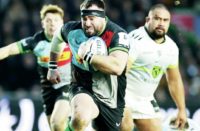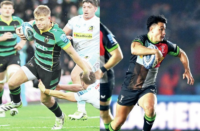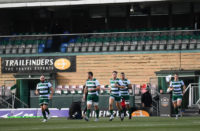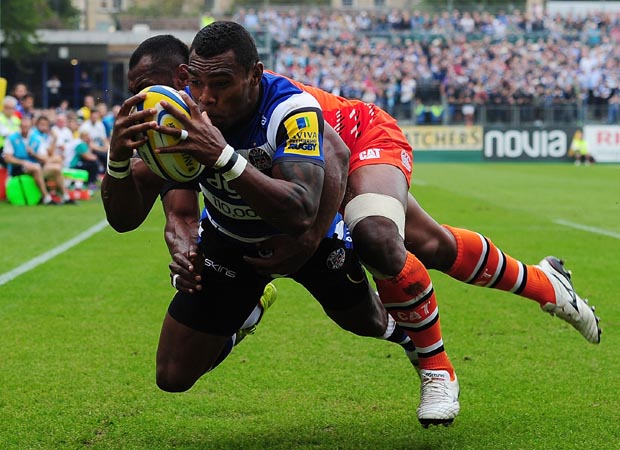 Semesa Rokoduguni's selection in the 33-man England squad announced this week for the autumn internationals could be Stuart Lancaster's chance to conjure up his own Chris Oti moment. Oti was the wing introduced to spice up England's attack in the 1988 Six Nations, and the Nigerian-born Wasps finisher with super-sized thighs answered the call with a hat-trick of tries in a 35-3 demolition of the Irish at Twickenham.
Semesa Rokoduguni's selection in the 33-man England squad announced this week for the autumn internationals could be Stuart Lancaster's chance to conjure up his own Chris Oti moment. Oti was the wing introduced to spice up England's attack in the 1988 Six Nations, and the Nigerian-born Wasps finisher with super-sized thighs answered the call with a hat-trick of tries in a 35-3 demolition of the Irish at Twickenham.
Oti's spree prompted the Twickenham throng to break into a spontaneous rendition of the “Swing Low Sweet Chariot”, the gospel anthem that England fans then adopted to urge Will Carling's team towards a World Cup final and two successive Grand Slams.
It prompts the thought that Lancaster would give his eye-teeth for anything close to the record achieved by Carling and company as he surveys the obstacle-course that lies ahead of his team over the next 12 months.
As for Rokoduguni, the odds are stacked against him making the same impact as Oti. First, and of greatest concern, Lancaster suggested that the Fijian-born British Army and Bath wing might not get up to defensive running-speed in time to take on the All Blacks. Given that England have two weeks solid for an elite professional rugby player to learn their defensive system you would think that if the Red Rose coaches were unable to integrate him successfully then their own abilities are in question.
Assuming that Rokoduguni passes muster on the defensive front we can then get to the area which will dictate whether England can do the business at home against the Southern Hemisphere big three this autumn. Attack.
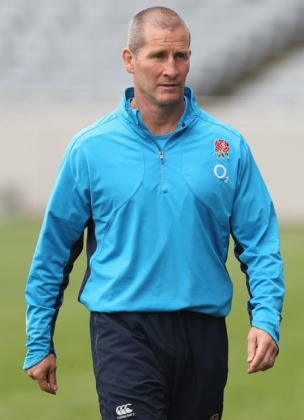
The Bath man is in the Bryan Habana mould when it comes to having an explosive combination of pace, power and balance, and England will be the beneficiaries if they can unleash him. However, expecting Rokoduguni to score a hat-trick of tries on his debut against the reigning world champions – which Ireland definitely were not when Oti ran riot – is more comic-book hero territory than that inhabited by mortals.
What he could do, whether or not he gets among the try-scorers, is be an inspirational force who provides England with a means of taking the game to New Zealand.
The big drawback is that Rokoduguni appears to be in a minority of one. Put plainly, he has attracted attention because, outside the 27-year-old wing, and in the pack No.8 Billy Vunipola, Lancaster's squad is largely inspiration-free.
Its most disappointing aspect is that it retrenches around the squad that has finished second in the Six Nations for the last three seasons, and in most respects fails to build on some of the brighter aspects of the New Zealand tour and the start of this Premiership season.
It is not so much one single selection decision that gives that impression, but the cumulative effect of a number of close calls going to players who are more reliable than inspirational.
Owen Farrell's instant recall at 10 after playing very little rugby since the second Test against New Zealand in Dunedin following foot, knee and quad injuries, raises concerns. Farrell showed what he can do against New Zealand last season, whereas George Ford's credentials against teams of world-class calibre are unknown. He has earned his spurs with Bath this season and merits a chance to face that test right now, and the All Blacks is a good a place to start.
Lancaster needs to know this autumn whether he is ready either to challenge Farrell for the No.10 shirt, or be back-up to him. Had Ford been given the chance to start against Scotland last season – as I advocated in these pages at the time – we would know more. Instead, barring another injury to Farrell, he will probably not get his chance until the night game against Samoa.
Another flair fly-half struggling to get England match-action is Danny Cipriani. His summer tour rehabilitation has come to a halt, with the all-round efficiency of Stephen Myler rated more highly in the autumn pecking order.
Where there was no room in the back three for either Christian Wade, who showed again against Leinster his unrivalled ability to score tries from nowhere, or David Strettle – who has been the Premiership's form wing with Rokoduguni – Jack Nowell and Jonny May are back for the autumn.
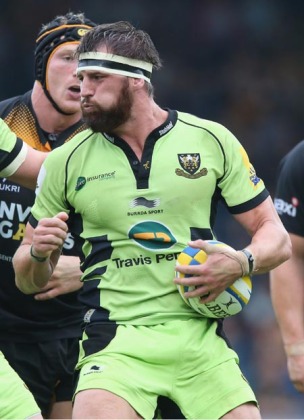
If consistency and reliability are Lancaster's mantras then, in attack, his wing selection does not add up. Nowell and May did not manage a try between them during the last Six Nations, and the Exeter youngster's strike rate in the Premiership was at the lower end. However, in defence Nowell was rock steady. If he can be as good in attack this autumn he merits selection, if not he is being given selection breaks denied to others.
This brings us to the heart of the matter, which is Lancaster's coaching outlook – and the more the head coach explained his selections at Wednesday's press conference the more conservative it appeared.
At one point he said: “To be the best, it is not about the flash stuff. It is actually about skill execution and everything being done at a high level. If we take Jonny Wilkinson as the benchmark, he didn't get everything right all the time and it wasn't always flash, but he was incredibly consistent in everything he did. It is all the little things we look for.”
Yes, he was extraordinary in his consistency – but holding up Wilkinson as the opposite of flash does not work. Much of what Wilkinson did was not only flash, as in brilliant, but inspirational. A winning drop-goal off your weaker foot in a World Cup final is flash. So is a tackle that flattens a wing as big and powerful as France's Emile Ntamack, not to mention the great quality and range of his passing, and superb kicking of every sort.
As for flash, as in flashy, Wilkinson was never one to showboat. The closest he came is in the bonus section of the “Jonny Wilkinson Tribute Toulon” on the web, where the maestro reveals his box of tricks. It's worth a look.
Reliability is of course a crucial component in an international player, but so is inspiration – and Wilkinson had both. The issue with Lancaster's squad is that there is an overload of reliability and a dearth of the inspirational players who can change the course of Test matches.
It is, as it has always been, a question of getting the blend right. The back row selection sums up the dilemma the England head coach faces, and the solutions he favours.
When I suggested to Lancaster that his back-row selection contained four blindsides – Tom Wood, Calum Clark, Chris Robshaw and James Haskell – and two No.8s, and that in order to play the high-tempo game that he favours specialist openside link-men and ball-winners are essential, he suggested his options were limited (See Front Page story).
Lancaster said: “You pick your squad on the players you have got. If you are a club coach you can go and recruit a Julian Salvi or (Michael) Hooper.”
He then switched tack, defending his autumn series captain, Robshaw. “Chris has more involvements as a link player than any player in the competition (Premiership). That is one thing he does extremely well.”
He also emphasised the size and fitness of his back-row selection, citing Northampton's success in the process, and explaining how Clark has forced his way into the reckoning ahead of a formidable carrier like Dave Ewers.
“The fittest forward in our tests was Calum Clark. He has the biggest engine – he beat Tom Wood, who has got a pretty good engine himself. Robshaw's engine is obviously good. That (no opensides) was not the reason we lost the third Test (against New Zealand). Northampton have gone the route and won the Premiership final on the back of having big back-rowers, whether it is Wood and Clark, or Fisher and Dowson, or whatever, it works. There is not the model that you can say, ‘that will definitely work or that definitely doesn't work'.”
Yet, while the No.7 door looks to have swung shut on Steffon Armitage, Lancaster is keeping his options open. He said that he expects two of the Premiership's most promising opensides, Will Fraser (Saracens) and Matt Kvesic (Gloucester), to be included when a handful of players are added to the autumn training squad this week.
There is little doubt, however, that in the first instance it is the big back row guys with big engines who will get to face New Zealand. They will have to fire-up first time, otherwise England's mix of solid reliability and Farrell's boot will not be enough to get their autumn campaign into gear.
*This article was first published in The Rugby Paper on October 26


